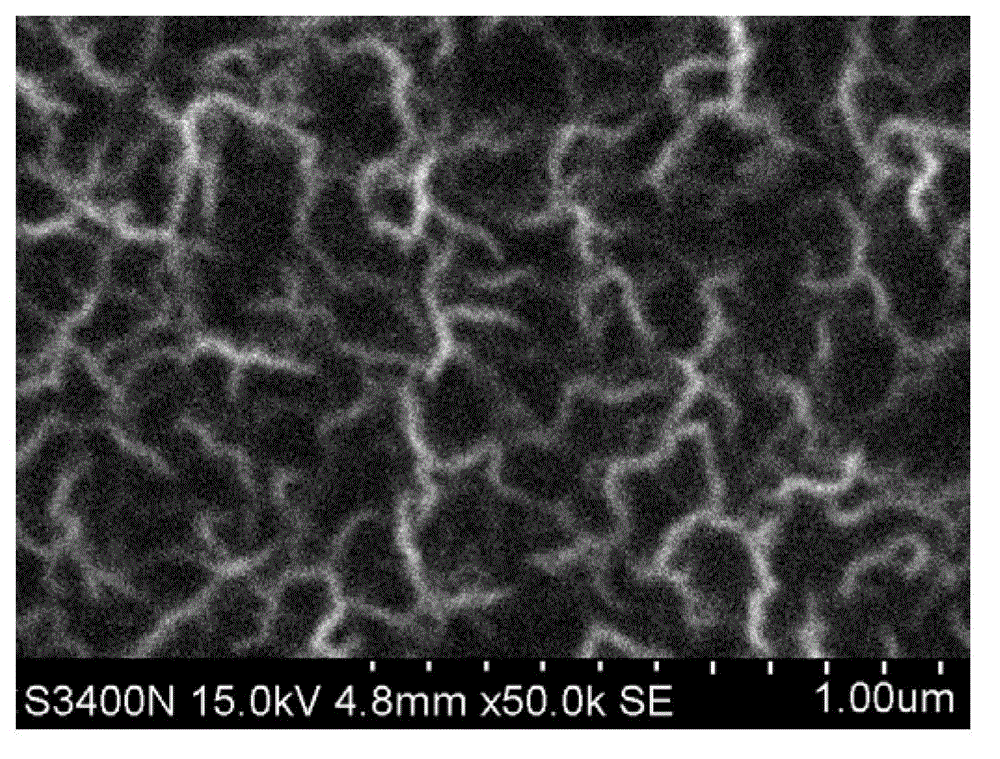Carbon nanowall and graphene nanoribbon preparation method
A technology of graphene nanobelts and carbon nanowalls, which is applied in the direction of nanotechnology, nanotechnology, chemical instruments and methods, and can solve the problem of low conductivity
- Summary
- Abstract
- Description
- Claims
- Application Information
AI Technical Summary
Problems solved by technology
Method used
Image
Examples
preparation example Construction
[0027] Such as figure 1 Shown, the preparation method of the carbon nanowall of one embodiment, comprises the steps:
[0028] Step S110: Etching the metal substrate in an acid solution with a concentration of 0.01 mol / L˜1 mol / L for 0.5 minutes˜10 minutes.
[0029] By etching the metal substrate, defects are generated on the etched surface of the metal substrate, which can effectively improve the surface structure of the metal substrate, so that carbon nanometer walls can grow on the surface of the metal substrate.
[0030] Among them, the acid solution is preferably hydrochloric acid solution, sulfuric acid solution or nitric acid solution. The concentration of the acid solution is preferably 0.1 mol / L-0.5 mol / L; the etching time of the metal substrate in the acid solution is preferably 60 seconds-180 seconds. Optimum etching conditions can achieve good etching effect and improve the growth efficiency of carbon nanowalls.
[0031] Wherein, the metal substrate may be a commo...
Embodiment 1
[0055] The preparation of the graphene nanobelt of the present embodiment is as follows:
[0056] (1) Preparation of carbon nanowalls: (a) Put the nickel foil in a hydrochloric acid solution with a concentration of 1mol / L and etch it for 0.5 minutes, and then wash it with deionized water, ethanol, and acetone in sequence after etching; (b) wash the Put the finished nickel foil into the reaction chamber, and remove the air in the reaction chamber, heat the nickel foil to 900°C, then turn on the ultraviolet light source equipment, let the ultraviolet light irradiate the surface of the nickel foil, and then pass in methane and nitrogen to keep For 100 minutes, the flow rate of methane steam was 200 sccm, and the flow ratio of methane steam to nitrogen was 2:1. After the reaction was completed, stop feeding methane steam, stop heating the nickel foil, and turn off the light source equipment. After cooling down to room temperature, the nitrogen gas flow was stopped, and the carbon ...
Embodiment 2
[0062] The preparation of the graphene nanobelt of the present embodiment is as follows:
[0063] (1) Preparation of carbon nanowalls: (a) Put the iron foil in a sulfuric acid solution with a concentration of 0.5mol / L to etch for 4 minutes, and wash it with deionized water, ethanol, and acetone in sequence after etching; (b) Put the cleaned iron foil into the reaction chamber, and remove the air in the reaction chamber, heat the iron foil to 600°C, then turn on the ultraviolet light source equipment, let the ultraviolet light irradiate the surface of the iron foil, and then pass in ethane vapor and argon for 200 minutes, wherein the flow of ethane steam is 100 sccm, and the flow ratio of ethane steam to argon is 5:1. After the reaction is completed, stop feeding ethane steam and stop heating the iron foil , and turn off the light source equipment, after the reaction chamber is cooled to room temperature, stop feeding argon gas, obtain the carbon nanowall of this embodiment on ...
PUM
| Property | Measurement | Unit |
|---|---|---|
| Wavelength | aaaaa | aaaaa |
| Length | aaaaa | aaaaa |
| Conductivity | aaaaa | aaaaa |
Abstract
Description
Claims
Application Information
 Login to View More
Login to View More - Generate Ideas
- Intellectual Property
- Life Sciences
- Materials
- Tech Scout
- Unparalleled Data Quality
- Higher Quality Content
- 60% Fewer Hallucinations
Browse by: Latest US Patents, China's latest patents, Technical Efficacy Thesaurus, Application Domain, Technology Topic, Popular Technical Reports.
© 2025 PatSnap. All rights reserved.Legal|Privacy policy|Modern Slavery Act Transparency Statement|Sitemap|About US| Contact US: help@patsnap.com



